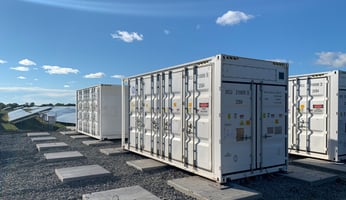Rising Energy Costs in Ohio: How Energy Storage Can Lower PJM’s Rising Capacity and Transmission Costs for Your Community

Capacity and transmission costs in Ohio are rising; we are seeing short-term increases now and expect more significant hikes in the longer term. Ohio's electricity rates are increasing due to factors such as inflation, substantial load growth, and the costs associated with upgrading, operating, and maintaining utility systems. According to the Public Utilities Commission of Ohio (PUCO), Ohio consumers can expect to face significant electricity price increases in the coming years as utilities factor in the rising costs of fuel, transmission, and capacity.
For years, most municipal utilities in Ohio have maintained safe and reliable systems, keeping rates significantly lower for their customers compared to those served by investor-owned utilities (IOUs). However, municipal utility customers are now experiencing rate increases, prompting proactive municipal utilities to take steps to mitigate the impact on their customers.
In this blog, we’ll explore why capacity and transmission costs in PJM—the grid operator for the Mid-Atlantic, including Ohio—have surged, and how your utility can address these costs with a battery energy storage system, sometimes paired with solar photovoltaic (PV).
Why are PJM Capacity and Transmission Costs Increasing?

In the most recent capacity auction, PJM Interconnection experienced a notable price increase of about 800%, with the final clearing price rising to $269.92 per megawatt-day across most zones in Ohio. This represents a significant rise from last year’s prices—around $28.92 per megawatt-day. This increase reflects a combination of load growth, insufficient new generation as older units retire, and changes in market dynamics. The next capacity auction is expected to incorporate reforms aimed at stabilizing prices and ensuring reliability.
As Ohio works to maintain a reliable energy grid, the reduction of traditional fossil fuel generation is contributing to a shifting energy landscape. Utilities must now be more proactive in mitigating rising capacity and transmission costs through strategic solutions like energy storage and efficiency measures.
As a result, Ohio is also experiencing a notable rise in transmission costs. For 2025, transmission rates are projected to increase, reflecting the investment required in infrastructure to support the region's evolving deliverability and reliability needs. As the energy landscape continues to shift, continued transmission cost increases are expected, further underscoring the complexities and challenges faced by the market in balancing cost and reliability.
 Columbus, Ohio is subject to rising costs PJM capacity and transmission costs
Columbus, Ohio is subject to rising costs PJM capacity and transmission costs
Energy storage and solar PV can help utilities better manage these rising costs and increase system reliability, ultimately benefiting communities.
How Battery Storage Can Lower Your Community’s Energy Costs
For utilities aiming to reduce capacity and transmission costs or hedge against future increases, energy storage is an optimal solution. As Ohio enters a transition period with many variables and a changing energy landscape, battery storage is critical to both limit cost increases and maintain reliability.
If you are looking to insulate your community against rising capacity and transmission costs, energy storage is an optimal solution. Often referred to as the “Swiss Army knife” of solutions, battery storage can not only shave capacity and transmission peaks, but address system reliability and redundancy needs that may be unique to each municipality.
To meet the electric grid’s highest periods of consumption, also known as “peak demand,” utilities often rely on natural gas peaker plants, which can quickly ramp up production to meet the needs of the grid. These plants, however, are expensive and carbon intensive. Battery storage systems, on the other hand, produce no on-site greenhouse gas emissions, and may be deployed to augment peaking capacity or replace the need for peaking generation entirely! In addition, battery storage systems can help utilities avoid costly transmission and distribution system upgrades.
The features of a battery energy storage system include a small footprint, quiet and pollution-free operations, instantaneous response, and the ability to provide added local capacity during grid peaks, making it an ideal solution for utilities.
Battery energy storage is also increasingly being paired with solar photovoltaics (PV). Solar PV can reduce your capacity costs directly, and battery storage can maximize the value of the solar to the grid, storing solar-generated electricity for after the sun sets.

How to Get Started with Energy Storage
Convergent Energy and Power, a leading developer of energy storage and solar PV across North America, owns, operates and maintains renewable energy systems on behalf of customers—determining the peak times to charge and discharge the battery storage system for optimal value creation using its propriety energy storage intelligence, PEAK IQ®.
Convergent has been in the energy storage industry since its infancy, for nearly 15 years. Throughout that time, we’ve gained experience and expertise, working closely with utilities throughout North America to take the hassle out of energy storage. We’re proud to say that it has never been easier to integrate energy storage into your utility and the time has never been better—especially in places where energy costs are rising.
If you’re interested in learning more about how energy storage (with or without solar generation) can benefit your utility and community in the face of rising capacity and transmission prices, please contact us today.

VP, Business Development
647.332.6460
lkatz@convergentep.com
Lisa Katz is Vice President of Utility Origination at Convergent Energy & Power. Lisa has over 15 years of experience working closely with global and domestic businesses and utilities to reduce their energy cost and carbon footprint. Her unique blend of experience includes sales management, public policy, business strategy, marketing, and project management in diverse markets that span power generation, combined heat and power, biogas, renewable natural gas, hydrogen and environmental controls.




